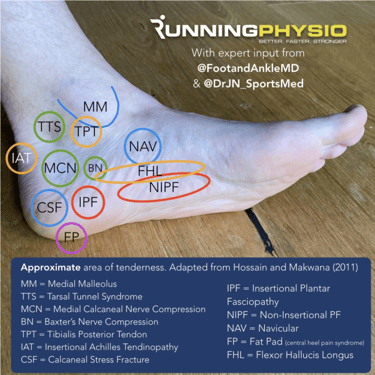There are numerous running myths out there and many of them are related to running form. Probably...
Not all Heel Pain is Plantar Fasciitis
How do you know if your heel pain is plantar fasciitis or something else?
Plantar fasciitis is a super common cause of foot pain, typically presenting as pain on the bottom of the foot where the arch connects to the heel bone. It can also sometimes extend into the arch itself.
Most people assume that when they have pain in the bottom of the foot, it is plantar fasciitis. While this can oftentimes be true, it is important to recognize that pain in this general location is not always plantar fasciitis, and step 1 to solving your foot pain is to make sure you know what is actually causing the pain.
What else could it be?
Running physiotherapist Tom Goom has created a great chart to help visualize the other potential considerations when deciding what is causing your heel pain:
We can break the likely causes of heel pain down into these 5 main categories:
- Nerve (green circles)
- Bone (blue circles)
- Fat pad (purple circle)
- Other tendinopathies (red circles)
- Plantar fasciopathy/fasciitis (red circles)
While knowing these approximate location variations can be a good starting point, it is also helpful to know the variation in how symptoms present for each of the above.
Nerve pain is commonly described as numbness, tingling, burning, or shooting symptoms. These can be constant or consistent with certain movements.
Bone pain varies a lot in description, but commonly used descriptors are an aching or sharp pain. The presentation of symptoms can be super helpful to consider as well - as bone pain typically doesn’t warm up with activity, it typically gets worse with more impact/activity.
The calcaneal fat pad can become irritated and be a common source of heel pain, and its location is typically most similar to plantar fasciitis. While plantar fasciitis typically has a classic presentation of warming up with more movement, an irritated fat pad is more correlated with time on feet. Think: standing for long periods, especially with less cushion under your heel (like if standing barefoot). The fat pad’s role is to act as a cushion to the bone and tissues below it, but it can become irritated and be a common source of pain.
Other tendinopathies are typically more obvious to dissociate between plantar fasciitis, however their presentation and pain description is often the same as plantar fasciitis. This is where knowing the typical location of pain is helpful, as well as knowing what activities make it better or worse - as variation in movements place more/less stress on different tendons.
While there are varying stages of plantar fasciopathy/fasciitis, the most common presentation is a gradual onset of symptoms, early morning stiffness/pain with the first few steps, a warm up affect both in the morning and with activity, stiffness returning after activity/use, and worse pain the next day after an increase in activity.
When you’re in pain it is important to find the root cause of the pain in order to solve it as quickly as possible. Each of the different injury types above present differently, and each also has unique things to emphasize for treatment.
If you’re stuck with trying to figure out what is causing your heel pain or what to be doing about it - we can help! We’re experts in all of the above injuries and help active people with these issues daily. Respond to this email to set up a free discovery call to get started.
Be sure to send this to a friend with heel pain!






